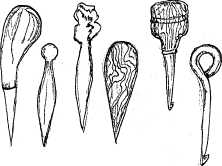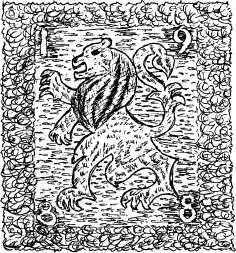| JOURNAL 1993 |
| North Craven Heritage Trust |
"As children we were allowed an extra half hour out of bed provided we used the time to cut clips"
"Everybody had diamond designs in their rugs, but I was tired of diamonds so I drew round a saucer and made shell shapes!"
"My mother always cut clips with pointed ends because they were easier to push through the backing"
"That's my special SUNDAY rug—these days they wouldn't know it was Sunday if there wasn't something different!"
"Everybody made up their own designs—old Mrs Hannam was especially good at that"
As soon as rag rugs are mentioned, nearly everyone of a certain age has a story to tell—men as well as women. The making of rugs from worn out clothes was a central activity in households of the north for a long period of time. It is difficult to say when it started, but it seems likely that the factory system of cloth production meant that people had more clothes and therefore material was available for rug making.
Everything was used and nothing was wasted. The rugs were pegged on old hessian feed sacks which, in some areas such as Upper Ribblesdale, were stretched on to a home-made wooden frame. Since we have been demonstrating rug making we have been interested to hear on a number of occasions from people originating from the Burnley area of Lancashire, that they do not remember a frame being used—their mothers and grandmothers simply stretched the material tightly over their knees!
The tools used for pushing the clips through the hessian were made from any suitable piece of wood or metal smoothed and sharpened—old curtain rods, pieces of poker, half dolly pegs etc., even horn or bone. The prodder needs to sit snugly into the hollow of the hand, and, having found a comfortable one, people are loth to part with it.
At the end of winter the housewife would sort through the family clothes, and any that were beyond repair would be washed, dried and put away until the Autumn. As the nights began to draw in, the frame was set up and everyone from youngest to oldest, men and women, family and friends, had a part to play in clipping, prodding or hooking.
Some people remember rug making with pleasure and nostalgia, while others shudder to be reminded of a tedious chore.
The clips consisted of small bits of material cut into uniform pieces, about 2" long and l" wide, and thousands of clips were needed to make a rug. No wonder the children's labour was essential to the enterprise!
Designs depended on the colour and texture of the material available. In Horton-in-Ribblesdale, which was a railway village, railwaymen's old uniforms were frequently used to make a dark thick border. Brightly coloured material was particularly prized and everyone tried to get some bright red in somewhere. At a farm near Ribblehead there is an especially interesting rug, which is still in very good condition, and which contains pieces of cream serge from a bride's outfit dating from the early years of this century. If the technique of hooking rather than prodding was used, long thin strips of soft cloth were required. A favourite source of material for this method was old lisle stockings and stockinet underwear!
A pegged rug ends up with a long, thick pile, so that the design is not clear cut. Often there was a dark border with the centre filled in with clips picked at random from a large bag of mixed colours. Sometimes the clips were sorted into groups of colours and a design based on geometrical shapes. Hooky rug designs can be much more detailed. Flower patterns were popular and some people even made pictures of animals or local scenes.Having amassed a mountain of clips and decided on the design, a start could be made on pegging (known as prodding or progging in some areas), and the work continued in every spare moment until the rug was finished. Friends calling in to visit would join in, courting couples would start on a rug for their new home. When the new rug was finished it would take pride of place in front of the main hearth, and the old one would be relegated to a less conspicuous position, the lowliest place being outside the back door for the men to wipe their boots on. After that we like to think that its last resting place was the compost heap, since all its components were natural fibres and therefore biodegradable.
There is now a revival of interest in this traditional craft. The wealth of fabrics and colours now available have inspired many new and imaginative designs, but the excitement and satisfaction of making something new and pleasing, from materials that would otherwise have been discarded, is the same as it was for our forebears.
PEGGED OR PRODDY RUG:
—this type is worked with the wrong side facing you.
1. Cut rags into strips 2" long and 1/2-3/4" wide.2. Poke a hole in the hessian, push one end of the strip down through this first hole.
3. Make another hole l/4" away from the first and push the other end of the strip through this. Pull both ends to the same length.
4. Take another strip of material and poke this also through your second hole.
5. Make the next hole 1/4" away and poke the other end of the strip through, as before.
HOOKY RUG:
—This type is worked with the right side facing you.
1. Cut rags into long strips l/2" wide.
2. Using hook, poke a hole in the hessian backing.
3. Holding the long strip underneath, push the hook down
and bring up the end of the strip to the top in a loop.
4. Push the hook through again 1/4" further on, and pull
up the next bit of the strip to form another loop.
5. Continue in this manner, keeping loops as even as possible—about
1/4 " high. Start a new strip in the same hole as the end of the previous
one.
Sheila Haywood and Margaret Barker.

J1993p10_20_files/tmpBB9-16.jpg
Prodders and Hooks can be made from almost anything!

J1993p10_20_files/tmpBB9-17.jpg
Rug design for the Golden Lion Hotel, Horton-in-
Ribblesdale, when it reopened in 1988. The border is
in "proddy" and the lion design in "hooky".
Drawn by Henry Barker.

J1993p10_20_files/tmpBB9-18.jpg
PEGGED OR PRODDY RUG:

J1993p10_20_files/tmpBB9-19.jpg
HOOKY RUG: